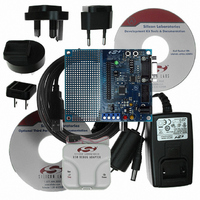C8051F310DK Silicon Laboratories Inc, C8051F310DK Datasheet - Page 126

C8051F310DK
Manufacturer Part Number
C8051F310DK
Description
DEV KIT FOR C8051F310/F311
Manufacturer
Silicon Laboratories Inc
Type
MCUr
Specifications of C8051F310DK
Contents
Evaluation Board, Power Supply, USB Cables, Adapter and Documentation
Processor To Be Evaluated
C8051F31x
Interface Type
USB
Silicon Manufacturer
Silicon Labs
Core Architecture
8051
Silicon Core Number
C8051F310
Silicon Family Name
C8051F31x
Lead Free Status / RoHS Status
Contains lead / RoHS non-compliant
For Use With/related Products
Silicon Laboratories C8051, F310, 311 MCUs
Lead Free Status / Rohs Status
Lead free / RoHS Compliant
Other names
336-1253
Available stocks
Company
Part Number
Manufacturer
Quantity
Price
Company:
Part Number:
C8051F310DK
Manufacturer:
SiliconL
Quantity:
10
- Current page: 126 of 228
- Download datasheet (2Mb)
C8051F310/1/2/3/4/5/6/7
12.4. External Crystal Example
If a crystal or ceramic resonator is used as an external oscillator source for the MCU, the circuit should be
configured as shown in Figure 12.1, Option 1. The External Oscillator Frequency Control value (XFCN)
should be chosen from the Crystal column of the table in SFR Definition 12.4. For example, an
11.0592 MHz crystal requires an XFCN setting of 111b.
When the crystal oscillator is first enabled, the oscillator amplitude detection circuit requires a settling time
to achieve proper bias. Introducing a delay of 1 ms between enabling the oscillator and checking the
XTLVLD bit will prevent a premature switch to the external oscillator as the system clock. Switching to the
external oscillator before the crystal oscillator has stabilized can result in unpredictable behavior. The rec-
ommended procedure is:
Note: Tuning-fork crystals may require additional settling time before XTLVLD returns a valid result.
The capacitors shown in the external crystal configuration provide the load capacitance required by the
crystal for correct oscillation. These capacitors are "in series" as seen by the crystal and "in parallel" with
the stray capacitance of the XTAL1 and XTAL2 pins.
Note: The load capacitance depends upon the crystal and the manufacturer. Please refer to the crystal
data sheet when completing these calculations.
For example, a tuning-fork crystal of 32.768 kHz with a recommended load capacitance of 12.5 pF should
use the configuration shown in Figure 12.1, Option 1. The total value of the capacitors and the stray capac-
itance of the XTAL pins should equal 25 pF. With a stray capacitance of 3 pF per pin, the 22 pF capacitors
yield an equivalent capacitance of 12.5 pF across the crystal, as shown in Figure 12.2.
Important Note on External Crystals: Crystal oscillator circuits are quite sensitive to PCB layout. The
crystal should be placed as close as possible to the XTAL pins on the device. The traces should be as
short as possible and shielded with ground plane from any other traces which could introduce noise or
interference.
126
Step 1. Force the XTAL1 and XTAL2 pins low by writing 0s to the port latch.
Step 2. Configure XTAL1 and XTAL2 as analog inputs.
Step 3. Enable the external oscillator.
Step 4. Wait at least 1 ms.
Step 5. Poll for XTLVLD => '1'.
Step 6. Switch the system clock to the external oscillator.
Figure 12.2. 32.768 kHz External Crystal Example
32.768 kHz
22 pF
22 pF
Rev. 1.7
10 M
XTAL1
XTAL2
Related parts for C8051F310DK
Image
Part Number
Description
Manufacturer
Datasheet
Request
R
Part Number:
Description:
SMD/C°/SINGLE-ENDED OUTPUT SILICON OSCILLATOR
Manufacturer:
Silicon Laboratories Inc
Part Number:
Description:
Manufacturer:
Silicon Laboratories Inc
Datasheet:
Part Number:
Description:
N/A N/A/SI4010 AES KEYFOB DEMO WITH LCD RX
Manufacturer:
Silicon Laboratories Inc
Datasheet:
Part Number:
Description:
N/A N/A/SI4010 SIMPLIFIED KEY FOB DEMO WITH LED RX
Manufacturer:
Silicon Laboratories Inc
Datasheet:
Part Number:
Description:
N/A/-40 TO 85 OC/EZLINK MODULE; F930/4432 HIGH BAND (REV E/B1)
Manufacturer:
Silicon Laboratories Inc
Part Number:
Description:
EZLink Module; F930/4432 Low Band (rev e/B1)
Manufacturer:
Silicon Laboratories Inc
Part Number:
Description:
I°/4460 10 DBM RADIO TEST CARD 434 MHZ
Manufacturer:
Silicon Laboratories Inc
Part Number:
Description:
I°/4461 14 DBM RADIO TEST CARD 868 MHZ
Manufacturer:
Silicon Laboratories Inc
Part Number:
Description:
I°/4463 20 DBM RFSWITCH RADIO TEST CARD 460 MHZ
Manufacturer:
Silicon Laboratories Inc
Part Number:
Description:
I°/4463 20 DBM RADIO TEST CARD 868 MHZ
Manufacturer:
Silicon Laboratories Inc
Part Number:
Description:
I°/4463 27 DBM RADIO TEST CARD 868 MHZ
Manufacturer:
Silicon Laboratories Inc
Part Number:
Description:
I°/4463 SKYWORKS 30 DBM RADIO TEST CARD 915 MHZ
Manufacturer:
Silicon Laboratories Inc
Part Number:
Description:
N/A N/A/-40 TO 85 OC/4463 RFMD 30 DBM RADIO TEST CARD 915 MHZ
Manufacturer:
Silicon Laboratories Inc
Part Number:
Description:
I°/4463 20 DBM RADIO TEST CARD 169 MHZ
Manufacturer:
Silicon Laboratories Inc











